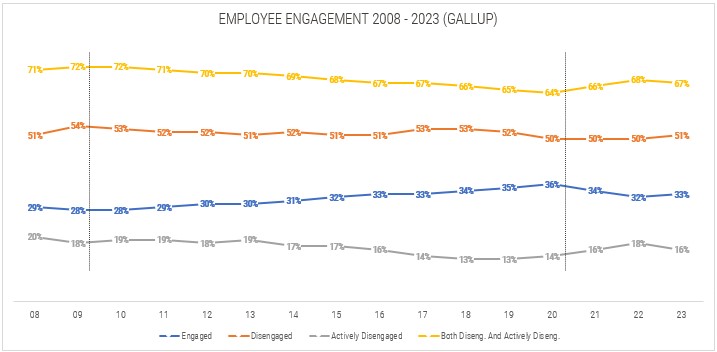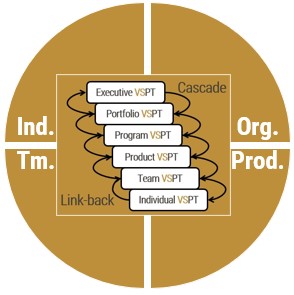In a recent Guerilla Leadership virtual coffee (every Friday at 8 am US Eastern Time) a few weeks ago this topic came up. Some of the attendees were saying that the results of their study at one of our clients that there is no correlation between Engagement and Performance.
So, I decided to investigate this topic to see what the literature and studies that are out there suggest. I have a few examples of the studies below sorted by those that show correlation, those that are inconclusive, and those that suggest that there is no correlation. After that, I’ll share my thoughts.
The Infamous Gallup Employee Engagement numbers
The following graph shows the trend lines from the Gallup Polls for Employee Engagement from 2008 through 2023:

And these numbers above are only for the US. The global surveys have lower numbers for engaged and higher numbers for actively disengaged, the cause of which may be due to a myriad of reasons.
The Yellow line above at the top is the combined total for Disengaged + Actively Disengaged for each year. The Orange line is the total for Disengaged. The Blue line is for Engaged. And the Gray line at the bottom is for disengaged.
The total average for this 16-year time span for each area is as follows:
- Disengaged + Actively Disengaged = 68.31%
- Disengaged = 51.63%
- Engaged = 31.69%
- Actively Disengaged = 16.69%
Most of the studies out there (here’s the link to the Google search I used) indicate that there is a correlation between Engagement and Performance, so here is a summary of some of those:
Correlated studies:
The results of this study showed that: “(1) There is a relationship between work engagement and job performance, which may not be linear but inverted U-shaped, and (2) psychological capital plays a moderating role in the inverted U-shaped relationship between work engagement and job performance.”
The results of this study showed that “we bring together these findings to identify the performance outcomes that most likely result from high levels of engagement.”
The results of this study showed that “Following a systematic literature review, we identified 174 unique studies. Studies had to be set in an organizational environment, include a measure of work engagement as well as an objective or subjective measure of performance, and offer information concerning the link between work engagement and job performance, irrespective of whether it was the main aim of the study…The findings highlight the importance of work engagement research for improving organizational performance.”
More research needed:
The results of this study found that: “In spite of this popularity, there is a scarcity of empirical research on work engagement in the academic literature. The relationship between work engagement and performance, in particular, is deserving of attention given our field’s focus on performance improvement. In this article, we review and analyze relevant research and then propose a research agenda to guide future research on this topic. Conclusions and implications for HRD and OD are discussed.”
No-correlation views:
Alec Levenson’s (click to see his LinkedIn profile) conclusion in the above article is that “Employee engagement and business results are statistically related because they are correlated: yet the causation usually runs from better business results to engagement, not the other way around. Even when you can show statistically that increased engagement in one year precedes increased business performance in the following year, as Harter, Schmidt and Hayes (2002) showed using the Gallup data, that does not prove causation.”
My thoughts and takeaways…
1. Engaged employees have almost no competition
First, on-the-average two (2) out of every three (3) team members are either disengaged or actively disengaged. I would tend to define those as “actively disengaged” as someone who is heartily working against the Vision, Mission, Purpose, Core Values & Attitudes, Strategies, and Goals & Objections of the organization:

In other words, they are a toxic pool of poison that, if not properly mitigated, will negatively impact, and potentially infect everyone around them (check out my post on How to Hug a Porcupine to go a little deeper on this topic). What this means for you, personally, is that if you are enthusiastic about (and engaged in) your role in the organization, then you are in a minority. This means that you have extraordinarily little competition if you are focused on building a career.
2. Showing up (even though the job is not engaging)
Second, based on the overall trends, people can show up and still deliver value, even if they are not engaged with their job. It would be interesting if this is a result of the Judeo-Christian work ethic on which the US was built? An individual pursuing excellence will always do their best regardless of how bad the work situation may be. They rise above the life-sucking, toxic environment in which they find themselves. To quote a manager from an international telecom (mobile carrier that really didn’t understand the mindset that many people have in desiring to improve their workplace) who said, “what’s the big deal? It’s just an ‘effing’ job!”

3. Companies are still surviving
Third, it is amazing that anyone stays in business with numbers this dismal. The friction that disengagement and active disengagement creates real, tangible losses. According to Gallup’s research, these losses total up to USD $8.8 Trillion per year! In the article they point out that “That’s equal to 9% of global GDP.”
Chris Vestal observed in today’s virtual coffee that the statistic above (the 9% of global GDP) could validate Jack Welch’s 10% rule where every year he would fire the bottom 10% of all underperformers in his organization. “The vitality model of former General Electric chairman and CEO Jack Welch has been described as a “20-70-10” system. The “top 20” percent of the workforce is most productive, and 70% (the “vital 70”) work adequately. The other 10% (“bottom 10”) are nonproducers and should be fired.”
Despite the losses, companies continue to exist. And a majority of the team members in most organizations are in a state of perpetual disengagement, or worse, active disengagement.
4. Is it Generational?
Also, in today’s meeting Jay Keller raised the question if this is a generational issue? Since many of the Guerilla Leadership Coaches and Trainers tend to be more advanced in their careers at this stage, it could be that we have a worldview that aligns with a Judeo-Christian work ethic.
Some of the research shared at the beginning of this article indicated that there were differences between different age demographics and so that would support this idea.
The Games we play
There are multiple “games” that people are playing in any organization:
- The career-promotion game
- The bonus game
- The retirement game
- The CYA game
If we really look at what is happening in any of these “games,” the reality is that people are trying to master the art of the Political Game to defend and advance their careers!
Whatever game you are playing (or think you are playing), a better path is to shift your mindset from Engagement/Disengagement to obtaining:
- Joy
- Contentment
At the upper end of the scale and avoiding:
- Discontentment
- Despair
At the other end of the scale. Using the Aha! Curve Principle & Mindset, I have added these four to the picture:

If an individual or team struggles for too long, then there is a risk that they sink into the abyss of despair. If they make it to the level of consistently going through the motions, then they may end up discontented.
It’s when the team rises to a level of being able to consistently perform, then they may reach a certain level of contentment. And my experience has been that when a team steps into a state of sustainable high performance, then that is achieving a state of pure joy (both to watch and to participate in).
Overcoming the effects of Employee Engagement / Disengagement requires using all eighteen (18) of the Principles & Mindsets included in Guerilla Leadership.
Getting everyone moving in the right direction…and winning…is both an art and science. -Andrew Kallman
Your thoughts? Let’s chat…
